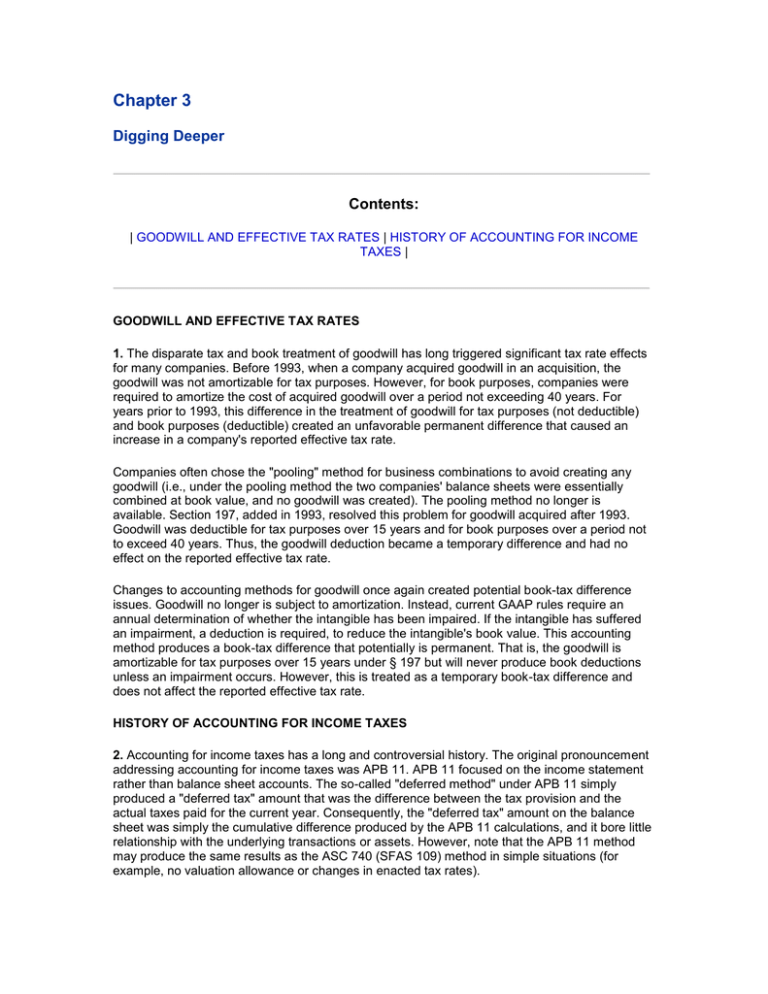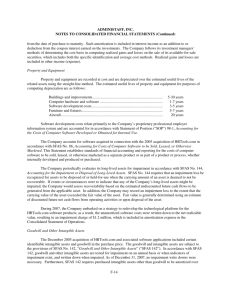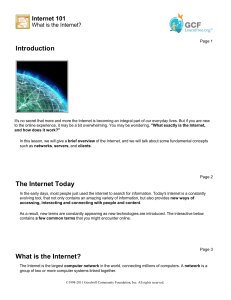
Chapter 3
Digging Deeper
Contents:
| GOODWILL AND EFFECTIVE TAX RATES | HISTORY OF ACCOUNTING FOR INCOME
TAXES |
GOODWILL AND EFFECTIVE TAX RATES
1. The disparate tax and book treatment of goodwill has long triggered significant tax rate effects
for many companies. Before 1993, when a company acquired goodwill in an acquisition, the
goodwill was not amortizable for tax purposes. However, for book purposes, companies were
required to amortize the cost of acquired goodwill over a period not exceeding 40 years. For
years prior to 1993, this difference in the treatment of goodwill for tax purposes (not deductible)
and book purposes (deductible) created an unfavorable permanent difference that caused an
increase in a company's reported effective tax rate.
Companies often chose the "pooling" method for business combinations to avoid creating any
goodwill (i.e., under the pooling method the two companies' balance sheets were essentially
combined at book value, and no goodwill was created). The pooling method no longer is
available. Section 197, added in 1993, resolved this problem for goodwill acquired after 1993.
Goodwill was deductible for tax purposes over 15 years and for book purposes over a period not
to exceed 40 years. Thus, the goodwill deduction became a temporary difference and had no
effect on the reported effective tax rate.
Changes to accounting methods for goodwill once again created potential book-tax difference
issues. Goodwill no longer is subject to amortization. Instead, current GAAP rules require an
annual determination of whether the intangible has been impaired. If the intangible has suffered
an impairment, a deduction is required, to reduce the intangible's book value. This accounting
method produces a book-tax difference that potentially is permanent. That is, the goodwill is
amortizable for tax purposes over 15 years under § 197 but will never produce book deductions
unless an impairment occurs. However, this is treated as a temporary book-tax difference and
does not affect the reported effective tax rate.
HISTORY OF ACCOUNTING FOR INCOME TAXES
2. Accounting for income taxes has a long and controversial history. The original pronouncement
addressing accounting for income taxes was APB 11. APB 11 focused on the income statement
rather than balance sheet accounts. The so-called "deferred method" under APB 11 simply
produced a "deferred tax" amount that was the difference between the tax provision and the
actual taxes paid for the current year. Consequently, the "deferred tax" amount on the balance
sheet was simply the cumulative difference produced by the APB 11 calculations, and it bore little
relationship with the underlying transactions or assets. However, note that the APB 11 method
may produce the same results as the ASC 740 (SFAS 109) method in simple situations (for
example, no valuation allowance or changes in enacted tax rates).
In 1987, SFAS 96 replaced APB 11, with significant changes in the method used to produce the
provision for income tax expense. SFAS 96 was controversial and its implementation was
delayed by the FASB several times. The terminology of "temporary differences" and "permanent
differences" was adopted in SFAS 96 (replacing the concept of "timing difference" in APB 11).
SFAS 96 also adopted the "balance sheet" approach, treating any book-tax difference in the
basis of a company's assets and liabilities as generating a future tax impact (tax savings or tax
cost). SFAS 96 required a number of complex hypothetical tax calculations based on expected
future reversal of temporary differences. However, the effect of future income and expense items
could not be considered in these hypothetical calculations.
SFAS 96 was quickly replaced with SFAS 109 in 1992 (now ASC 740). SFAS 109 continued with
the balance sheet approach and the concept of "temporary" and "permanent" differences. SFAS
109 did allow the consideration of expected future income and expenses in determining deferred
tax assets and liabilities. It also created the concept of a valuation allowance, requiring a
substantial amount of auditor judgment in determining the likelihood of deferred tax assets being
realized in the future.
© 2015 Cengage Learning. All Rights Reserved. May not be scanned, copied or duplicated, or
posted to a publicly accessible website, in whole or in part.



